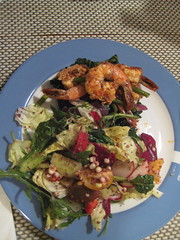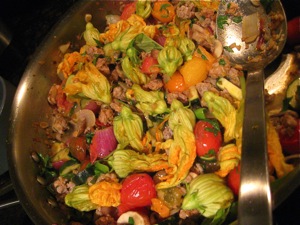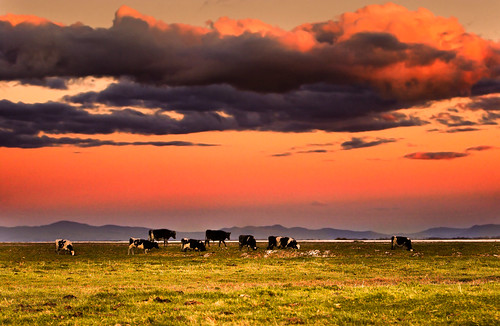Friday, July 31, 2009
Let Them Eat Meat
Thursday, July 30, 2009
New Report: Health Is Unhealthy!
Sunday, July 26, 2009
Zippity Doo Dah

It's been a little bit since I posted (thanks for the last entry, Beth! I actually froze some nectarines yesterday and put them in a drink. Mmmm....) and I admit, I've gotten a bit off topic. While the last few entries were cooking-based, and I firmly believe that cooking is one of the best first steps to becoming more aware of the origins of ones food, I think it's time to get serious again.
1. Turn it inside out
2. Wash/Rinse
Thursday, July 23, 2009
My Favorite Use of Peaches
If you want to keep it all close to home (those of you in the New York area), go get yourself some Tuthilltown Spirits Hudson Baby Bourbon.
I warmed the hearts of many guests in the cold weather months with this simple, wholesome victual. Let the fruit melt in your drink until you're done and then eat the slippery, liquor-soaked peach that's left in your glass. Heaven.
When freezing these fruits, choose fruit at the peak of ripeness and discard any bad spots. Cut out the pit, cut fruit into chunks (whatever size you like), and fill new freezer bags, pushing out air as much as possible before sealing.
You can also freeze fruits (and any foods, for that matter) in glass or plastic containers. As much as I love my glass mason jars, though, it is much easier to disengage the frozen-together chunks of fruit when they are in a plastic bag than in a container. Rather than stabbing into a container with a knife and risking bodily harm, you can take the sealed bag and hit it against a hard surface like your counter top to break it up.
Wednesday, July 22, 2009
Dunnie's Din

din
Originally uploaded by Utter Brandomonium
Got home from the gym and Dunnie was choppin' away. I chipped in minimally, and we had a wonderful, fresh, veggie-based dinner:
Salad of mixed organic greens from the farmers market, corn, kaniwa (quinoa-like grain from Peru), beets, radishes, cucumber, tomatoes, and red peppers, with lemon-parsley-shallot vinagrette
Garlic, ancho, cumin shrimp on wilted kale with garlic scapes and red onion
No recipes today!
Monday, July 20, 2009
Another Repice (no, not a typo)

A New, Long-Term Relationship

Cooking was never the abstract, distant, scary thing to me that it is to many people these days. It's just a process, and it always made sense. I would man the BBQ, make some eggs or french toast, make sandwiches and perform some basic tasks in the kitchen, but never really had to fend for myself. The first kitchen I had was sophomore year of college, when there was a 2-burner electric range, small oven, and a sink in the lounge of my dorm. So in my first attempt to cook anything "real", I called up a few friends and declared I was making dinner. It came out pretty darn good.
From that moment on, I knew that cooking was far more than just combining some ingredients, heating most of them up, and eating the finished product. Cooking, and the sharing of a collective meal, is as old as human civilization itself. Eating is the rarest of activities that combines all the senses at once. It caters to the most basic human needs of community, nourishment and comfort.
What began that day was not just a love of food and cooking, but a long-term relationship with the ingredients provided by the earth. And as my interest, experience, and sophistication grew, so did my understanding of the fragile, beautiful gifts that make it into my fridge and pantry. This blog, and my deep interest in what we eat and where it comes from, is the culmination of my most basic values, and experience as an eater and a cook. I admit to unabashed selfishness, however. I want the best ingredients, and they happen to be local, usually organic, and always the freshest possible. A world dominated by impersonal, wasteful, industrial food challenges me on a very deep level.
With that, I will post the first of what will hopefully be many recipes. This is a simple, delicious, wholesome (and awfully wintery, excuse the lack of seasonality) dish.
My mothers Lemon Chicken (updated ever so slightly)
Ingredients:
4 boneless free-range chicken breasts
1/2 cup chicken stock
1/2 cup Parmesan Reggiano cheese, freshly grated
2 cloves garlic, smashed and diced
1/2 cup fresh parsley, chopped
1/2 cup all-purpose flour
2 eggs
1 large lemon, cut in half with 4 thin slices taken out of thickest part
1 tbl milk or half-and-half
1 tsp pimenton (smoked Spanish paprika)
1-2 cups fresh bread crumbs (any old bread in a food processor will do)
1 tsp freshly ground black pepper
1 tsp kosher salt
4 tbl extra-virgin olive oil
Pre-heat oven to 350 deg F.
In a medium saucepan, heat 2 tbl olive oil and garlic over medium heat. When garlic starts to pop and begins to turn a light golden color, add the bread crumbs.Toast breadcrumbs until they are light golden brown throughout. Season with salt and pepper and half the parsley. Remove from heat and set aside.
In 3 medium shallow dishes, set up your breading station, one with flour, salt, pepper and pimenton, one with beaten eggs and milk, and one with the breadcrumbs. Meanwhile, heat remaining olive oil over medium heat in large saucepan. One oil shimmers, begin the breading and frying process. Dust chicken breasts with flour, making sure to pat most of it off, just barely coating. Then dip in egg and milk mixture, letting excess drip off. Finally dredge in bread crumbs, pressing them into the chicken to make sure they adhere. Finally place chicken in saute pan. Repeat with remaining chicken, keeping track of the order in which they went into the pan. Cook 2-3 minutes per side, until breadcrumbs are a medium brown and a crust has formed.
Place chicken in lightly-greased baking dish. Pour a bit of chicken stock and squeeze the lemon (not the slices) all over the chicken and into the baking dish. Make sure the chicken is not swimming in liquid or the breading will become soggy. Cover with aluminum foil and bake for 12-15 minutes. Next, remove foil, and sprinkle the cheese over the chicken. Bake another 5-8 minutes, or until top of chicken is crispy and the cheese has melted. Garnish with remaining parsely.
Serve with couscous or brown rice, and a simple wilted green such as kale or spinach. A bit of fresh ground nutmeg is an excellent additional seasoning.
Wednesday, July 15, 2009
Finally, a post that supports the name of this blog...
Read the full article here
Consumed
Among her comments, she discusses a theme repeated often on this page:
"As a Peace Corps volunteer in Outer Mongolia from 1995 to 1996, Ms. Raab watched as the cow she was about to eat was killed right in front of her. She believes Americans are at too great a remove from their food, how it is created and how it is processed. “That’s unhealthy,” she said."
Whimsy, fantasy, imagination, and ingenuity have quickly been overshadowed by the ugly, irresponsible, unhealthy, dishonest truth.
On a separate note, I think I'll get back on my "Fresh Direct " photoproject.
Tuesday, July 14, 2009
A Not-Food Breakfast, Then a Glimmer of Hope

Last weekend I traveled up to Niagara Falls, Canada for my close college friend's bachelor party. While it was great to catch up with old buddies (and pretend we were back in college - my liver disagrees with this decision, however), it was also a sad, sad look into the middle-America (and by extension, Canada) I haven't seen since graduating. (For now, i'll leave the discussion of how one of the 7 wonders of the natural world has been completely spoiled by tacky, glitzy casinos and hotels for another time)
Upstate New York and the towns near the Canadian border are decent places - rolling hills, green pastures, cornfields, and post-industrial cities struggling to find a new identity, most containing a number of quality universities. These are generally family-oriented places. But like most working-class towns in this country, eating and shopping establishments are dominated by giant, corporate-industrial chains. As a result, it was extremely difficult to find anything "edible," in the local/organic/sustainable/honest sense. Applebees, Bob Evans, Perkins, TGIFridays, and of course KFC, BK, the golden arches, and Taco Bell were all eager to sell a cheap, high energy meal. Garbage. Appropriate in a town monopolized by casinos. Breakfast was at Perkins, and was truly disgusting.
This is just further illustration of the well-known fact that Americans spend about half as much per capita on food than other westernized nations. In a society haunted by consumption and risk, we are more willing to drop a $20 chip on a blackjack table than $20 on breakfast. Ask me how that makes sense! For the first, you have a known disadvantage against the house, whereas on breakfast, you have a known advantage of eating a good meal.
But like I said in the post headline, I have also seen a few glimmers of hope. On Sunday, I returned to NYC and caught the tail end of the farmers market. I got some garlic scapes, local cherries, some late-season sugar snap peas, and some amazing andouille sausage from a farm in Putnam County that raises only grass-fed cows. There was a TV crew interviewing some of the purveyors and vendors, and an unusual buzz. Some guy was saying to the farmer at this particular stand that he "just read the Ominvores Dilemma" and was excited about the local food movement. Once he was gone and I ordered my sausages, I asked if that book has had an effect. His eyes lit up and he said plainly, "It changed everything. It changed our lives."
Now it's time to change yours.
Thursday, July 9, 2009
Cows are cute. Making them is not.

Wednesday, July 8, 2009
It is what it is, unless it isn't.
This whole thing is disturbing on a few fronts. On one hand, there is a constant struggle between the organic producers who have "gotten big" and those who say that in doing so they are selling out and losing their initial vision of an "alternative food system." Michael Pollan and the CEO of Whole Foods duked it out publically a few years ago and actually came to a reasonable understanding on the topic. And if you followed my directions and went out and saw Food, Inc, then you'd see that some of these people really truly believe that displacing commercial, industrial foods on the shelves of any store (even Walmart) is a good thing. Which I agree with. But on the other hand, at what point does it stop? This story illustrates my point perfectly. When the same big players are involved, the same old "foodpolitics as usual" (thanks Sarah) will be the norm.
Then again (I think I'm out of hands here) if a company manages to keep it's soul, then profits will be a good thing for the movement. Actually, that was the first hand. Hmm.
Lunch.
"Maybe you thought it might be otherwise. Maybe you thought the tide was finally turning, given all the focus lo these past years on health and exercise, on improving the diet and buying organic and eating locally, the hot success of "Omnivore's Dilemma" and "Food, Inc" and all the rest, not to mention a shiny overpriced Whole Foods on every street corner and farmer's markets flourishing in every small town and the outright command to eat well splayed across the cover of every copy of "O" magazine.
How adorable you are, with your sweet utopian naiveté. Turns out the American diet has not really improved one iota, is just as gluttonous, sugary, chemical-blasted, heart-diseased, fatty, bloated and death-inviting as ever. We have not learned a thing. Yay America!"
Tuesday, July 7, 2009
Countdown

Corn is the keystone species of the industrial food system, along with its sidekick, soybeans, with which it shares a rotation on most of the farms in the Midwest. I'm really talking about cheap corn — overproduced, subsidized, industrial corn — the biggest legal cash crop in America. Eighty million acres — an area twice the size of New York State — is blanketed by a vast corn monoculture like a second great American lawn.
Monday, July 6, 2009
This won't hurt. I'm serious...
As John Vucetich, assistant professor of animal ecology at Michigan Technological University, and Michael Nelson, associate professor of environmental ethics at Michigan State University said:
"Instead of hope, we need to provide young people with reasons to live sustainably that are rational and effective. We need to lift up examples of sustainable living motivated by virtue more than by a dubious belief that such actions will avert environmental disaster."
I'm going to focus this blog on one aspect of the whole issue: Food. And my first piece of advice is this: Go see the movie "Food, Inc." Here are showtimes: http://www.movietickets.com/movie_detail.asp?movie_id=66346
It's an easy first step in understanding how you can make a huge huge difference, three times a day.